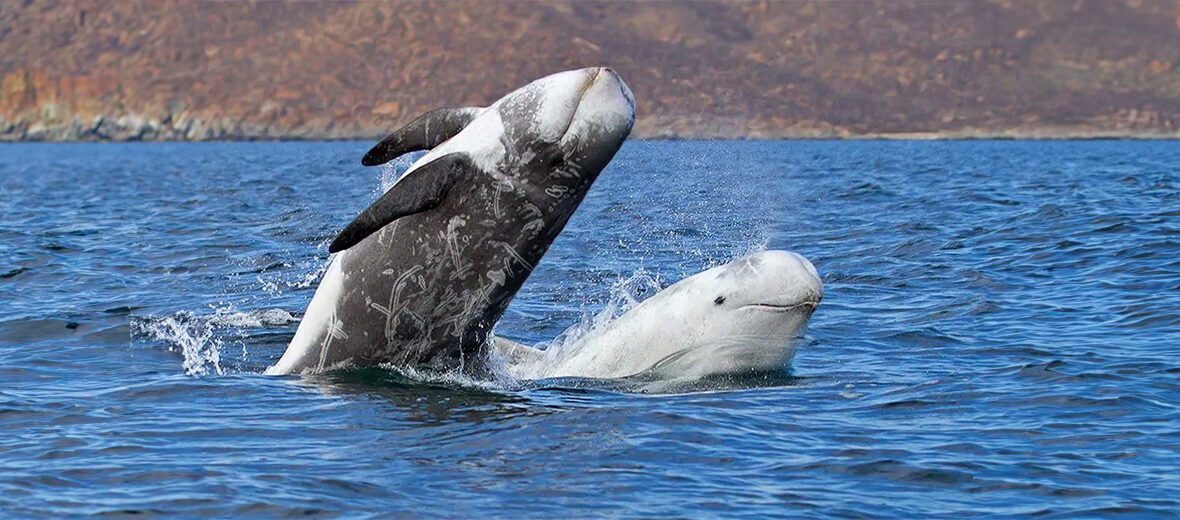
The Risso’s dolphin is the only species of the genus Grampus. Their closest relatives are pilot whales, melon-headed whales, pygmy killer whales, and false killer whales. These dolphins, like so many others, face the threats of overfishing; recreational activities that interfere with their daily activities and breeding habitats; war; civil unrest; military exercises; pollution; and climate change, that causes habitat alteration, shifting, and warmer waters. However, these critters are still abundant enough to be listed as Least Concern by the IUCN. Their population trend is unknown at this time.
First the Stats…
Scientific name: Grampus griseus
Weight: Up to 1,100 lbs.
Length: Up to 13 feet
Lifespan: Up to 35 years
Now on to the Facts!
1.) These dolphins are named after Antoine Risso, whose study of these animals formed the foundation of the recognized description by Georges Cuvier in 1812.
2.) While it is uncertain where the name grampus came from, the specific epithet griseus does refer to the mottled and seemingly scarred grey color of their body.
3.) Most individuals possess 2 – 7 pairs of teeth, all located in the lower jaw.
4.) Due to their maximum weight, these critters are the largest species of cetacean termed dolphins.
5.) Risso’s dolphins are found pretty much worldwide, from cold to temperate to tropical waters. They tend to avoid the extreme polar waters though.
But wait, there’s more on the Risso’s dolphin!
6.) Their preferred habitats are just off the continental shelf, among steep banks, with ocean depths ranging from 1,300 – 3,300 feet.
7.) The preferred water temperatures are from 59 – 68ºF.
Did you know…?
The common name for these dolphins “grampus” is a common name that is typically reserved for orcas.
8.) Since around 2017, Risso’s dolphins have started to appear off of the subarctic Norwegian coast. It is uncertain as to why. However, it is presumed that it is due to climate change or varying water currents driving prey northward, or competition with other cetaceans, like pilot whales.
9.) They prey almost exclusively on neritic and oceanic squid and octopuses.
10.) The Risso’s dolphin is predominantly nocturnal (active at night).
But wait, there’s still more on the Risso’s dolphin!
11.) These dolphins have been known to surf the bow waves of gray whales, as well as oceanic swells.
12.) They travel in pods numbering up to 51 individuals, but have been documented traveling in super pods consisting of several thousand individuals!
Did you know…?
These dolphins can dive to depths of up to 2,000 feet.
13.) Risso’s engage in fidelity towards their specific groups. Long-term bonds often correlate with adult males. Adult females with calves also stick together for a time. Younger individuals display less fidelity and often leave and join new pods.
14.) Like other dolphin species, Risso’s utilize echolocation to locate food.
15.) Risso’s dolphins don’t rely on cutting teeth to chew their cephalopod prey, which has allowed them to evolve teeth used as display weapons during mating conflicts.
But wait, there’s still a little more on the Risso’s dolphin!
16.) Females, aka cows, undergo up to a 14 month gestation (pregnancy) that yields a single calf.
17.) Calf birthing takes place approximately every 2.4 years.
Did you know…?
A famous Risso’s dolphin named Pelorus Jack was often reported between 1888 – 1912 as traveling with ships that were navigating the Cook Strait in New Zealand. A law protecting Pelorus Jack was passed after much public outcry.
18.) These dolphins have been successfully taken into captivity in Japan and the United States. They have even bred in captivity and have even interbred with other dolphin species producing hybrid species.
19.) North, Baltic, and Mediterranean Sea populations are listed on Appendix II of the Convention on the Conservation of Migratory Species of Wild Animals (CMS).
20.) Risso’s dolphins are currently protected in the United States under the Marine Mammal Protection Act of 1992.
Now a Short Risso’s Dolphin Video!
Be sure to share & comment below! Also, check out the Critter Science YouTube channel. Videos added regularly!
Want to suggest a critter for me to write about? Let me know here.
Some source material acquired from: Wikipedia & IUCN
Photo credit: Sergio Bitran M.




